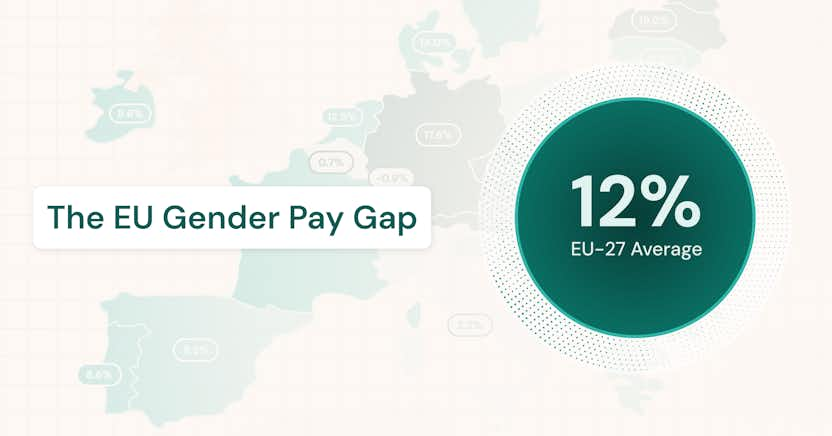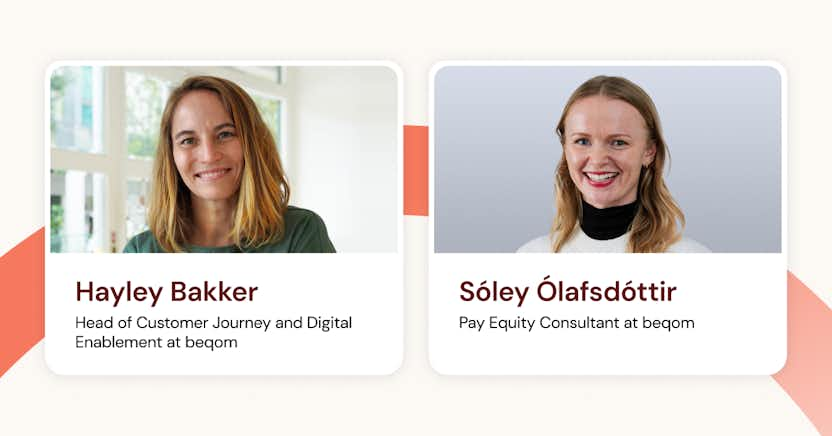DEI and Pay Equity: A Strategic Guide from Goal Setting to Execution

Learn more about the following beqom products
Diversity, equity, and inclusion (DEI) have been increasingly recognized as key pillars of a talent strategy aimed at strengthening company culture, employee performance, and brand reputation. Setting DEI goals and addressing pay equity are turning into mandatory focal points for organizations that want to achieve sustainable growth.
Recent initiatives—such as over 2,500 CEOs signing The CEO Action for Diversity & Inclusion pledge—highlight a growing commitment to these values. Moreover, a Pew Research Center survey reveals that 56% of U.S. employees view DEI enhancement positively. Abundant research further links DEI to improved financial performance, innovation, and employee satisfaction, underscoring the urgency for actionable strategies in this domain.
This article aims to serve as a comprehensive guide for companies intent on setting and achieving DEI goals, with a particular emphasis on pay equity. It provides practical steps and insights to transform commitment into tangible results. Our goal is to equip organizations with the knowledge and tools needed to create a more inclusive and equitable workplace.
The concept of DEI explained
What is DEI?
DEI stands for diversity, equity, and inclusion. This conceptual framework incorporates practices, programs, and policies to represent and support employees, regardless of an individual’s background, identity, skills, and experience.
Although DEI applies to all employees, its integration typically focuses on those who have “historically been underrepresented or subject to discrimination.” The main goal of DEI initiatives is to analyze and address how marginalized groups are treated to remove any disparities that may exist within an organization.
Here are the three aspects of DEI.
Diversity
Diversity refers to embracing the presence of variety within the workforce. This can include differences in age, ethnicity, race, gender, sexual orientation, religion, culture, marital status, physical abilities, and socioeconomic status.
Equity
Equity involves the fair treatment of individuals in the workforce. As opposed to equality, which assumes that everyone should be treated the same regardless of their differences, equity considers the advantages, barriers, and unique circumstances of individuals.
Inclusion
Inclusion ensures that everyone feels welcome, heard, and respected despite their differences. Through the practice of inclusion, all employees will feel supported and valued by their organization without needing to shield any part of their identity.
Benefits of DEI
The value of strategic compensation and pay equity has been widely recognized. DEI can improve almost every aspect of an organization and promote a high-performance culture. Its key benefits include:
Higher employee retention: By fostering positive experiences in a work environment, DEI can improve employee satisfaction, making them feel safe and empowered, ultimately reducing turnover
Increased adaptability: Studies have found that improvement in DEI is linked to a corresponding increase in a company’s ability to change, directly linked to their overall performance and employee engagement
Better decision-making: A diverse work environment suggests unique perspectives, improving the decision-making process
Improved financial performance: Companies with ethnic, gender, and cultural diversity are associated with higher market shares, more customers, and larger profits
Trust in leadership: DEI can facilitate greater trust between employees and leadership by prioritizing inclusivity, respect, and transparency.
Understanding DEI goals
Setting attainable and measurable DEI goals is imperative to harness the benefits of establishing a diverse, equitable, and inclusive work environment.
DEI goals are designed to address inequalities within a workforce, allowing organizations to take proactive steps and continuously measure their progress. DEI goals for pay equity should be objectives that encourage fair compensation for all employees and remove any current or future pay disparities.
Examples of DEI goals
Diversity
Ensure a diverse workforce in various roles by providing new opportunities for promotions for underrepresented groups.
Example - Increase the representation of minority groups in management positions by 20%, specifically focusing on roles that receive higher compensation, to promote an equitable distribution of pay between varying demographics.
Equity
Examine gaps in compensation among different demographic groups and identify their root cause to set clear objectives that remove pay inequities.
Example - Maintain 100% base pay equity for employees in comparable roles and ensure consistent, predefined processes for bonuses to eliminate biased outcomes.
Inclusion
Provide inclusive benefits and wellness programs.
Example - Expand healthcare benefits to include mental health services, ensuring coverage for at least 80% of employees by the end of the year.
By setting DEI goals, companies can make informed, fair, and effective pay decisions that contribute to a transparent and thriving work environment.

How to set up DEI goals step by step
Creating DEI goals is essential for building a more inclusive and equitable work environment. This guide outlines steps to develop, execute, and sustain these goals effectively.
Step 1: Assess current DEI status and pay structure
This involves a deep dive into the composition of your workforce, examining diversity levels, equity in treatment, and the inclusiveness of your workplace culture. Equally important is a detailed analysis of your pay structure to uncover any disparities that may exist.
By evaluating these elements with transparency and honesty, organizations can identify specific areas for improvement, setting the stage for targeted DEI goals that drive meaningful change.
Step 2: Get stakeholders’ perspectives
Encouraging everyone to share their experiences and perspectives allows the organization to identify meaningful areas for improvement. This phase involves structured approaches like one-on-one interviews with leadership, focus groups, and company-wide surveys.
Each method aims to capture diverse viewpoints, ensuring that the DEI initiatives resonate across the organization. Such a collaborative approach ensures that DEI goals are not just top-down directives but reflect a shared commitment to fostering a more inclusive and equitable workplace.
Step 3: Define relevant, clear, and measurable DEI goals
Properly defining organizational goals is an essential aspect of successful goal management. Structured goal-setting frameworks can streamline the process of setting DEI goals effectively and ensure alignment with organizational objectives. Here are the major goal-setting frameworks.
- SMART goals, standing for setting objectives that are:
- Specific
- Measurable
- Achievable
- Realistic
- Timely
- OKRs (Objectives and Key Results) where you define objectives, expected results, and the steps to achieve them
- KPIs (Key Performance Indicators), which involves tracking performance through specific, quantifiable measures across different areas of the organization
- Backward goal setting, which means you start with the end goal and plan actions backward to the present, setting smaller milestones along the way
- MBO (Management by Objectives), setting specific objectives for managers to align departmental goals with the organization's overall strategy
Step 4: Align DEI goals with industry standards and organizational strategy
To synchronize DEI goals with both the wider industry benchmarks and your unique organizational strategy, consider the following approach:
Benchmark against industry standards
Match your DEI efforts against those of industry leaders to pinpoint where you excel and where there's room for growth. It's about understanding your position in the landscape and setting goals that push for industry leadership in DEI.
- Identify industry benchmarks in workforce diversity, equity in promotion practices, and inclusion measures
- Compare your organization's diversity metrics against industry standards to identify where you stand
- Tailor DEI goals to address specific gaps while pushing towards industry leadership and be prepared to adjust goals and strategies based on evolving industry practices
Incorporate organizational strategy
This strategic alignment ensures that your DEI efforts are not only ambitious and relevant, but also directly contribute to your organization's success.
- Embed DEI considerations into every aspect of business strategy, from talent management to customer engagement
- Ensure DEI goals complement the overall mission and strategic objectives of your organization
- Integrate DEI initiatives into business planning and operational strategies for seamless execution
- Regularly review DEI progress against organizational strategy and adjust your goals accordingly
Step 5: Develop metrics and procedures for tracking progress
Identify Key Performance Indicators (KPIs) for evaluating DEI and pay equity progress
To gauge the effectiveness of DEI and pay equity initiatives, it’s crucial to establish and monitor specific KPIs that offer a comprehensive view of DEI initiatives across different facets of the organization.
- Financial commitment: Assess the allocation and distribution of the DEI budget
- Recruitment and hiring: Monitor diversity in the application and interview processes and track acceptance rates among diverse candidates
- Organizational diversity: Measure the representation of underrepresented groups within the workforce, including leadership positions and board composition
- Career advancement: Keep tabs on the promotion rates of diverse employees to track career mobility
- Engagement and culture: Evaluate employee engagement, satisfaction scores, and perceptions of the organization's DEI commitment
- Retention: Analyze turnover rates, with a focus on diversity within the workforce and leadership roles
Plan for regular monitoring and review
Implement a schedule for regular assessment of these KPIs to track changes over time. This could involve quarterly reviews to adjust strategies as needed.
Employ surveys, assessments, and other tools to gather accurate data. Employee satisfaction surveys and retention rate calculators can provide valuable feedback on the current DEI goal status.
Leverage beqom's pay equity platform for actionable insights
Solutions like beqom’s pay equity platform can help you gather actionable insights through advanced workforce analytics. Such tools can streamline data collection and analysis, making it easier to identify trends and disparities.
The thorough analysis of the data acquired enables you to spot trends, patterns, or significant changes, highlighting areas of success and those requiring further attention.
By establishing clear metrics and regularly evaluating them, organizations can create a feedback loop that fosters continuous improvement in their DEI efforts. This structured approach not only highlights progress but also pinpoints areas needing strategic adjustments.
Step 6: Evaluate, adjust, and communicate DEI goals
With the regular evaluation of progress and open communication of DEI goals, organizations can create a dynamic strategy that evolves to meet the needs of their diverse workforce. Use all findings and KPIs to refine DEI goals and strategies, ensuring they remain effective and relevant.
Transparency in communication is another critical aspect you should focus on. Clearly define DEI goals and ensure they are understood across the organization. Share updates on progress towards DEI goals and celebrate achievements to boost morale, enhance accountability, and motivate continued effort.
Best practices for achieving DEI goals and pay equity
Achieving DEI goals and establishing pay equity requires a comprehensive approach that considers all aspects of an organization’s operations.
Best practices for the successful implementation of DEI efforts and pay equity initiatives include:
Ensure diversity-focused recruitment and onboarding
Adopting practices that focus on attracting and onboarding a diverse pool of candidates is the first step towards effective pay equity across all organizational roles. Engaging in blind recruitment is a practice that removes the impact of unconscious biases, ensuring an equitable hiring process.
Encourage employee engagement
Anonymous surveys, one-on-one meetings, and group discussions allow employees to express their concerns and offer valuable insight regarding the organization's DEI initiatives and pay equity progress.
Promote employee development
Providing ongoing training and development programs tailored to diverse employee needs allows equal opportunities for promotion and advancement, which is essential for achieving DEI goals.
Choose an effective DEI partner
DEI partners can provide invaluable expertise and resources to support the implementation of pay equity initiatives, improve company diversity, and achieve DEI goals.
Gartner’s Digital Technologies Driving DEI Outcomes report mentions providers such as beqom that offer technology-based pay equity software solutions as opposed to strictly consulting-oriented services.
Technology-based solutions allow greater control for organizations to manage their pay equity efforts. Conversely, consulting-based services require ongoing hiring of consultants which can incur unnecessary costs.
Organizations that seek a sustainable approach and want to embed their pay equity initiatives into daily compensation procedures may benefit more from a technological solution offered by beqom.
Overcome challenges in DEI and pay equity efforts with beqom
By embracing diversity, ensuring fair treatment, and focusing on eliminating discrimination among employees, DEI goals can strengthen a brand’s reputation and image.
Through advanced pay equity software, organizations can overcome obstacles and ensure consistent progress toward their DEI goals.
Contact us to learn how to make fairness and equity a reality in your organization.







